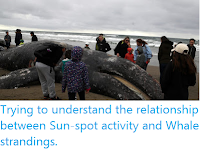The March Equinox falls at 3.49 pm GMT on Frid 20 March this year. The Earth spins on its
axis at an angle to the plain of the Solar System. This means that the
poles of the Earth do not remain at 90° to the Sun, but rather the
northern pole is tilted towards the Sun for six months of the year (the
northern summer), and the southern pole for the other six months (the
southern summer). Thius twice a year neither pole is inclined
towards the Sun, on days known as the equinoxes.
The tilt of the Earth relative to the incoming light of the Sun at the March Equinox. Przemyslaw Idzkiewicz/Wikimedia Commons.
The equinoxes fall each year in March and September, with the March
Equinox being the Spring (or Vernal) Equinox in the Northern Hemisphere
and the Autumn Equinox in the Southern Hemisphere, while the September
Equinox is the Autumn Equinox in the Northern Hemisphere and the Spring
Equinox in the Southern Hemisphere. On these two days the day and night
are both exactly twelve hours long at every point on the planet, the
only days on which this happens.
The tilt of the Earth relative to the Sun at the planet's equinoxes and solstices. Astronomy Group/University of St Andrews.
See also...
Follow Sciency Thoughts on Facebook.








